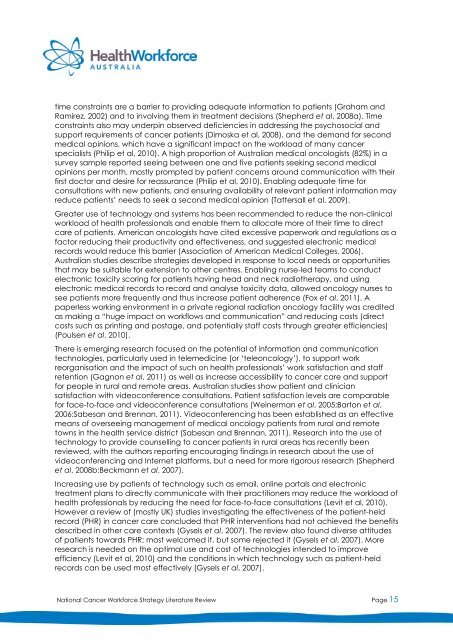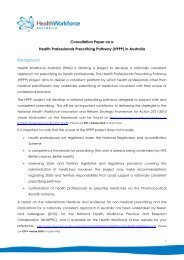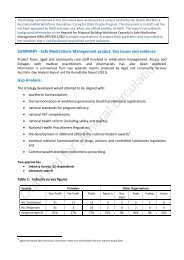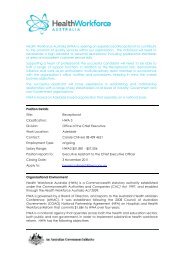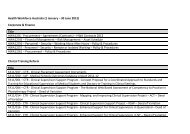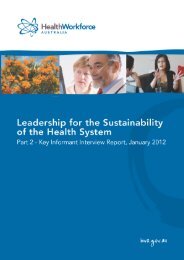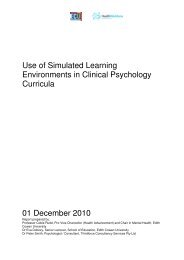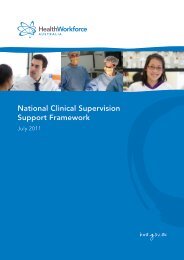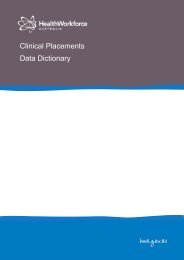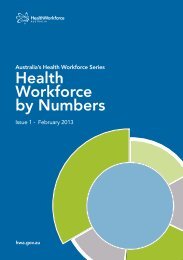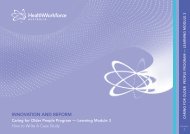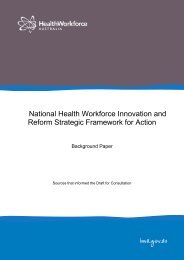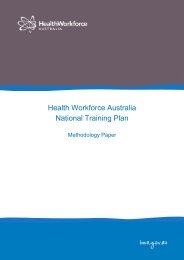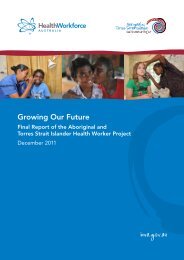time constraints are a barrier to providing adequate information to patients (Graham andRamirez, 2002) and to involving them in treatment decisions (Shepherd et al, 2008a). Timeconstraints also may underpin observed deficiencies in addressing the psychosocial andsupport requirements of cancer patients (Dimoska et al, 2008), and the demand for secondmedical opinions, which have a significant impact on the workload of many cancerspecialists (Philip et al, 2010). A high proportion of <strong>Australia</strong>n medical oncologists (82%) in asurvey sample reported seeing between one and five patients seeking second medicalopinions per month, mostly prompted by patient concerns around communication with theirfirst doctor and desire for reassurance (Philip et al, 2010). Enabling adequate time forconsultations with new patients, and ensuring availability of relevant patient information mayreduce patients’ needs to seek a second medical opinion (Tattersall et al, 2009).Greater use of technology and systems has been recommended to reduce the non-clinicalworkload of health professionals and enable them to allocate more of their time to directcare of patients. American oncologists have cited excessive paperwork and regulations as afactor reducing their productivity and effectiveness, and suggested electronic medicalrecords would reduce this barrier (Association of American Medical Colleges, 2006).<strong>Australia</strong>n studies describe strategies developed in response to local needs or opportunitiesthat may be suitable for extension to other centres. Enabling nurse-led teams to conductelectronic toxicity scoring for patients having head and neck radiotherapy, and usingelectronic medical records to record and analyse toxicity data, allowed oncology nurses tosee patients more frequently and thus increase patient adherence (Fox et al, 2011). Apaperless working environment in a private regional radiation oncology facility was creditedas making a “huge impact on workflows and communication” and reducing costs (directcosts such as printing and postage, and potentially staff costs through greater efficiencies)(Poulsen et al, 2010).There is emerging research focused on the potential of information and communicationtechnologies, particularly used in telemedicine (or ‘teleoncology’), to support workreorganisation and the impact of such on health professionals’ work satisfaction and staffretention (Gagnon et al, 2011) as well as increase accessibility to cancer care and supportfor people in rural and remote areas. <strong>Australia</strong>n studies show patient and cliniciansatisfaction with videoconference consultations. Patient satisfaction levels are comparablefor face-to-face and videoconference consultations (Weinerman et al, 2005;Barton et al,2006;Sabesan and Brennan, 2011). Videoconferencing has been established as an effectivemeans of overseeing management of medical oncology patients from rural and remotetowns in the health service district (Sabesan and Brennan, 2011). Research into the use oftechnology to provide counselling to cancer patients in rural areas has recently been<strong>review</strong>ed, with the authors reporting encouraging findings in research about the use ofvideoconferencing and Internet platforms, but a need for more rigorous research (Shepherdet al, 2008b;Beckmann et al, 2007).Increasing use by patients of technology such as email, online portals and electronictreatment plans to directly communicate with their practitioners may reduce the workload ofhealth professionals by reducing the need for face-to-face consultations (Levit et al, 2010).However a <strong>review</strong> of (mostly UK) studies investigating the effectiveness of the patient-heldrecord (PHR) in cancer care concluded that PHR interventions had not achieved the benefitsdescribed in other care contexts (Gysels et al, 2007). The <strong>review</strong> also found diverse attitudesof patients towards PHR: most welcomed it, but some rejected it (Gysels et al, 2007). Moreresearch is needed on the optimal use and cost of technologies intended to improveefficiency (Levit et al, 2010) and the conditions in which technology such as patient-heldrecords can be used most effectively (Gysels et al, 2007).National Cancer <strong>Workforce</strong> Strategy <strong>Literature</strong> Review Page 15
New models of post-treatment follow up and survivorship and increased referral to palliativecareIncreasing survival rates mean cancer is increasingly considered and managed long-term asa chronic disease. There has been growing focus on the needs of people with cancer aftertreatment ends – for survivorship care and ongoing follow-up, or for appropriate and wellcoordinatedpalliative care. Survivorship, palliative care, family caregiving and the ‘medicalhome’ have emerged as key models of care in oncology in the US (Levit et al, 2010).Improving follow-up and delivery of survivorship careSurvivorship is now recognised as a distinct phase of the cancer trajectory. In recognition ofcancer survivors’ ongoing physical and psychosocial needs, new models of care areevolving to improve follow-up and coordination of care and reduce demand on oncologists.It has been suggested these needs could be addressed by transitioning care of most cancersurvivors to primary care or community-based health professionals following treatment(Hewitt et al, 2006; Potosky et al, 2011; Brennan et al, 2011). Ensuring a smooth transition andmeeting survivors’ complex care needs would require better communication andcoordination of care between all health professionals involved in post-treatment care,particularly cancer specialists and primary care providers (Hewitt et al, 2006;Brennan et al,2011). Treatment summaries and written survivorship care plans are effective and essentialways of improving communication between care providers and coordination of follow-upand survivorship care (Hewitt et al, 2006;Potosky et al, 2011;Brennan et al, 2011).Randomised controlled trials have demonstrated the safety, cost-effectiveness andacceptability of primary care follow-up of women with breast cancer (Grunfeld et al, 2006)and of colorectal cancer patients (Wattchow et al, 2006) when compared with specialistfollow-up. There is evidence that primary care professionals expect/are willing to providefollow-up care to their patients with cancer (Wattchow et al, 2006;Bulsara et al, 2005;Cheunget al, 2009) but there is continuing confusion over roles and responsibilities with both primarycare providers and oncologists expecting to be the lead physician in follow-up (Cheung etal, 2009). In <strong>Australia</strong> there has been lack of consensus among survivors, GPs, surgeons andoncologists about which type of clinician is best to coordinate follow up (Baravelli et al,2009). Survivors expect or prefer their oncologists to provide all or a lot of follow-up care(Bulsara et al, 2005;Cheung et al, 2009). Although studies show survivors support increasedinvolvement of their GP (Baravelli et al, 2009), a breast physician (Brennan et al, 2008) or aspecialist nurse (Jiwa et al, 2009) in survivorship care, it is primarily in a supportive rather thantreatment role (Bulsara et al, 2005;Brennan et al, 2011).Hence, models of ‘shared care’ between GPs and specialists may be more successful andacceptable to survivors than a complete transfer of care to a GP or nurse (Brennan et al,2011). Patient preferences for specialist-based model of care are most likely related toconcerns about GPs, nurses or other care providers not having the skills or knowledge toprovide the required level of care without additional training (Brennan et al, 2011). The needfor increased training in follow-up and survivorship care is supported by findings of a survey ofcommunity-based primary care physicians (PCPs) in the US. Findings demonstrated that whilePCPs provided the bulk of care for long-term survivors, only a small subset reported providingmultidimensional survivorship care (i.e. screening for medical late effects, addressing sexualdysfunction and addressing mental health issues as well as monitoring for cancer recurrence)(Bober et al, 2009). Oncologists have questioned the capacity of primary care providers toconduct appropriate testing for cancer recurrence and care for late effects in women withbreast cancer (Potosky et al, 2011). However randomised controlled trials have shown thatwhen PCPs were given explicit directions for follow-up care (similar to a brief survivorship careplan) they achieved the same outcomes as specialists (Grunfeld et al, 2006).National Cancer <strong>Workforce</strong> Strategy <strong>Literature</strong> Review Page 16
- Page 6 and 7: o Reform health workforce roles to
- Page 11 and 12: • A lack of standards in training
- Page 14 and 15: lamed for creating confusion and hi
- Page 16 and 17: eceiving relevant medical and socia
- Page 20 and 21: Emerging research shows some cancer
- Page 22 and 23: DOMAIN 2: Health workforce capacity
- Page 24 and 25: of cancer patients in the community
- Page 26 and 27: deemed necessary for medical gradua
- Page 28 and 29: Posner 2007). This person-oriented
- Page 30 and 31: network, from clinicians delivering
- Page 32 and 33: DOMAIN 4: Health workforce planning
- Page 34 and 35: Shifts in workforce demographics an
- Page 36 and 37: DOMAIN 5: Health workforce policy,
- Page 39: It is important to recognise that c
- Page 43 and 44: http://canceraustralia.gov.au/sites
- Page 45 and 46: Dorgan S, Layton D, Bloo N, Homke R
- Page 47 and 48: Hemphill JK & Coons AE (1957). Deve
- Page 49 and 50: McClelland DC (1961). The Achieving
- Page 51 and 52: Shahid S, Finn L, Bessarab D & Thom
- Page 53 and 54: Valgus JM, Aimee F, Gregory KM, San
- Page 55 and 56: Appendix A: Database search strateg


